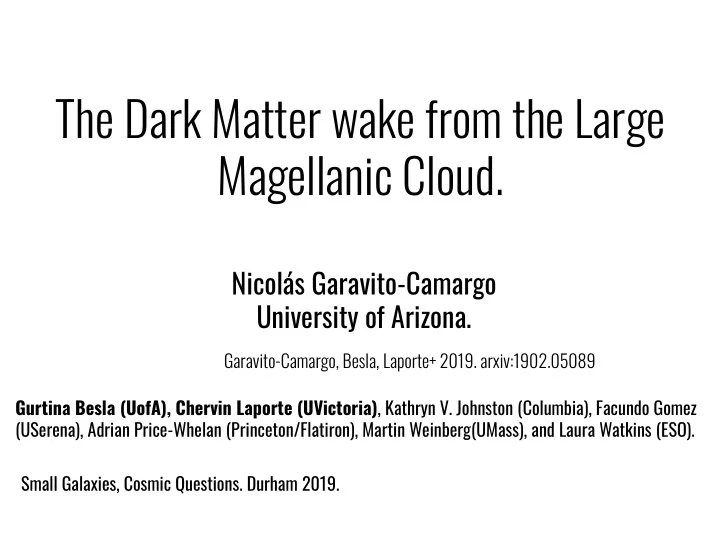

The Dark Matter wake from the Large Magellanic Cloud. Nicolás Garavito-Camargo University of Arizona. Garavito-Camargo, Besla, Laporte+ 2019. arxiv:1902.05089 Gurtina Besla (UofA), Chervin Laporte (UVictoria) , Kathryn V. Johnston (Columbia), Facundo Gomez (USerena), Adrian Price-Whelan (Princeton/Flatiron), Martin Weinberg(UMass), and Laura Watkins (ESO). Small Galaxies, Cosmic Questions. Durham 2019.
Satellite galaxies decay into host galaxies by transferring Energy and Angular Momentum to the DM halo of the host. Nicolás Garavito-Camargo (UofArizona)
DM wakes : Predicted by Dark Matter models yet not observed Chandrasekhar 43 White 83 Tremaine & Weinberg 84 Weinberg 98 Choi 09 Ogiya+16
The Large Magellanic Cloud induces the strongest Wake in the MW’s DM and stellar halo. ● It’s the most massive satellite of the MW. ~10 11 M ☉ at infall ○ Rotation curve ○ Abundance Matching ○ Timing argument ● It is on it’s first passage around the MW. ○ Besla07, Kallavayalil+13 ● It is at ~50 kpc Image credit: Besla+16 (inside the stellar and DM halo of the MW). Nicolás Garavito-Camargo (UofArizona)
N-body Simulations: of the MW & LMC. Live MW DM halo, stellar disk & bulge ● MW smooth stellar halo ● Live LMC DM halo. ● 4 LMC mass models [0.8, 1.0, 1.8, 2.5]x10 11 M ☉ ● 2 MW models Mvir 1.2x10 12 M ☉ ● Difgerent halo kinematics: Isotropic and Radially biased . Total: 8 N-body simulations. ● Realistic orbits of the LMC. within 2 σ of HST ● measurements of Kallivayalil+13 Mass resolution: m p = 1x10 4 M ☉ ● Run with P-gadget3 (Garavito-Camargo, Besla, Laporte+19) ● Similar sims used in Laporte 18a efgect of the LMC on the MW’s disk Nicolás Garavito-Camargo (UofArizona)
MW Halo Shape is not triaxial it’s shape changes with radii. Nicolás Garavito-Camargo (UofArizona)
In the presence of a massive satellite the shape of the halo is hardly triaxial. See also Vera-Ciro+14 Shao in prep (Garavito-Camargo+ in prep) Nicolás Garavito-Camargo (UofArizona)
The LMC produces a Wake in the DM distribution and stellar halo of the MW (Garavito-Camargo+ in prep) Nicolás Garavito-Camargo (UofArizona)
What are the observable signature of the Wake in a smooth stellar halo
The Wake in the stellar halo morphology in galactocentric coordinates: Isotropic MW Anisotropic MW At 45 kpc, the stellar Wake is 60% more dense than unperturbed regions of the stellar halo. (Garavito-Camargo, Besla, Laporte+19)
The Wake in the stellar halo morphology in galactocentric coordinates: Isotropic MW Anisotropic MW At 70 kpc, the stellar Wake is 60% more dense than unperturbed regions of the stellar halo. (Garavito-Camargo, Besla, Laporte+19)
Kinematic signature of the Wake: Flow of particles around the wake at 45 kpc. 45 kpc (Garavito-Camargo, Besla, Laporte+19) Nicolás Garavito-Camargo (UofArizona)
Kinematic signature of the Wake: Outflow of particles around the Wake at 70 kpc. 70 kpc (Garavito-Camargo, Besla, Laporte+19) Nicolás Garavito-Camargo (UofArizona)
However, the MW’s stellar halo is not smooth Nicolás Garavito-Camargo (UofArizona)
The Pisces Plume: An extended structure 60-100 kpc w/ LOS velocities consistent to those for the Wake. Belokurov, Deason +19. Nicolás Garavito-Camargo (UofArizona)
How to account for: 1. The stellar halo is not smooth.
How to account for: 1. The stellar halo is not smooth. 2. How to distinguish the gravitational potential from the LMC, LMC DM debris and the Wake?
Basis Field Expansions: An alternative method of gravity solvers Sample the phase space by approximating density and potential function expansion rather than sampling it with particles as traditional N-body methods. If the zeroth order term of the expansion is a good approximation of the DM halo, the expansion converge with low number of terms. Perfect tool to simulate the MW Clutton-Brock 73 (Plummer), Hernquist & Ostriker 92 (Hernquist), Lilley et al 2018a, 2018b (NFW, family of profiles), Weinberg, M 99 (Model free), Applied to N-body snapshots Lowing + 11 (Garavito-Camargo+ in prep) Nicolás Garavito-Camargo (UofArizona)
A BFE for the MW and LMC simulations. 2. BFE on MW + unbound 1. BFE on bound particles of the LMC particles of the LMC (Garavito-Camargo+ in prep) ~150 terms in the expansion to describe one snapshot of the simulation. Finding the terms that contribute to the expansion is not trivial (Weinberg 98). Nicolás Garavito-Camargo (UofArizona)
Conclusions: ● DM Wakes are a prediction of CDM, yet not observed. ● The LMC is creating the largest and strongest DM wake in the MW and hence the most likely to be observed. ● Density enhancements up to ~50% are expected in the stellar halo. ● Stars surrounding the Wake are moving either towards or outwards the Wake. ● BFE are a powerful tool to decompose the gravitational potential of the MW, the LMC, and the Wake. Also, to simulate known substructure in the stellar halo. Nicolás Garavito-Camargo (UofArizona)
Recommend
More recommend